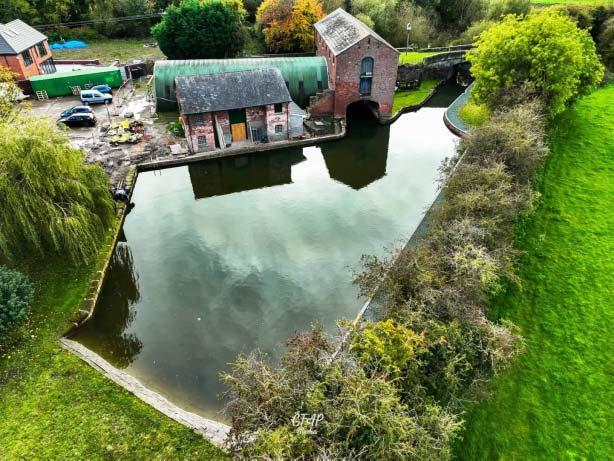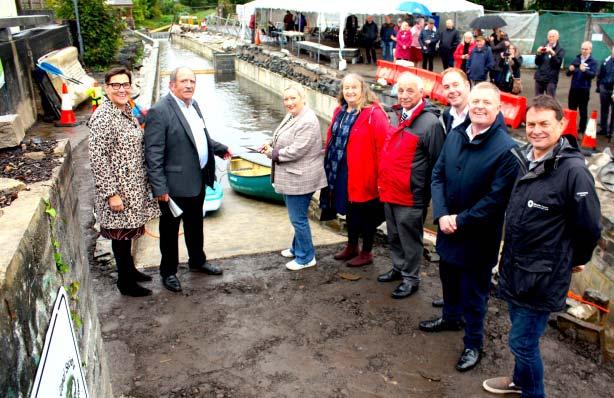volunteers restoring waterways volunteers restoring waterways

Canal Camps preview: Where we’re going in 2024
Canal Camps preview: Where we’re going in 2024


volunteers restoring waterways volunteers restoring waterways

Canal Camps preview: Where we’re going in 2024
Canal Camps preview: Where we’re going in 2024

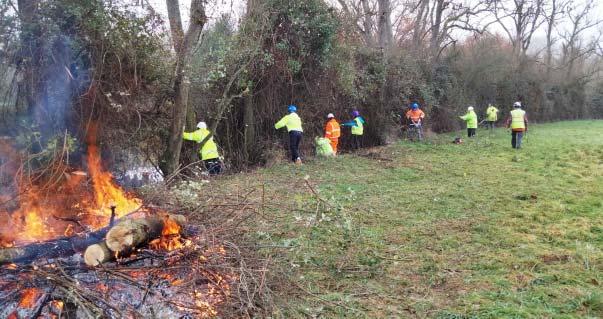
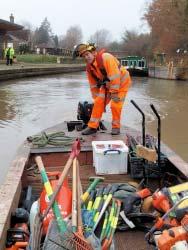
Regional mobile volunteer groups London WRG and Kescrg’s annual pre-Christmas working weekend was joined by WRG Forestry as well this year. Together they made a useful contribution to the Wey & Arun Canal Trust’s ongoing work to remove many canalside ash trees suffering from Ash Dieback Disease, as well as clearing undergrowth on the offside bank. They also marked the start of the WRG festive season with a Christmas party, themed to commemorate the Disney 100th anniversary. Can you work out what the costumes are?



For latest news on our activities visit our website wrg.org.uk
See facebook group: WRG
Follow us on Twitter: @wrg_navvies
Editor: Martin Ludgate, 35 Silvester Road, East Dulwich London SE22 9PB 020-8693 3266 martin.ludgate@wrg.org.uk
Subscriptions: Unit 16B, First Floor, Chiltern Court, Asheridge Road, Chesham HP5 2PX
Distribution: John Hawkins, 4 Links Way, Croxley Green WD3 3RQ 01923 448559 john.hawkins@wrg.org.uk
Navvies is published by Waterway Recovery Group and is available to all interested in promoting or supporting the restoration and conservation of inland waterways by voluntary effort in Great Britain. Articles may be reproduced in allied magazines provided that the source is acknowledged. WRG may not agree with opinions expressed in this magazine, but encourages publication as a matter of interest. Nothing printed may be construed as policy or an official announcement unless so stated - otherwise WRG and IWA accept no liability for any matter in this magazine.
Waterway Recovery Group is part of The Inland Waterways Association, (registered office: Unit 16B, First Floor, Chiltern Court, Asheridge Road, Chesham HP5 2PX), a nonprofit distributing company limited by guarantee, registered in England no 612245, and registered as a charity no 212342. VAT registration no 342 0715 89.
Directors of WRG: Rick Barnes, George Eycott, Emma Greenall, Helen Gardner, John Hawkins, Dave Hearnden, Nigel Lee, Mike Palmer, George Rogers, Jonathan Smith, Harry Watts.
ISSN: 0953-6655
PLEASE NOTE: subs renewal cheques MUST be made out to The Inland Waterways Association NOTE new subs address below
Editorial HS2, H&S, Defra and the rest 4-5
on doing it well 6
the Northern Canals Association 7 Coming soon BCN Clean Up and more 8-9 Camps preview all the sites we’ll (almost certainly) be visiting in 2024 10-17 Camp report WRG Forestry’s October Canal Camp on the Wey & Arun Canal 18-19
Diary Camps and working weekends 20-21 Dig report last instalment of the Cromford Canal pipe-and-manhole marathon 22-25
around the network 26-36
with Deirdre! 39
...are welcome, whether by email or post. Photos welcome: digital (as email attachments, or if you have a lot of large files please send them on CD / DVD or contact the editor first), or old-school slides / prints. Send contributions to the editor Martin Ludgate, see contact details above left. Press date for issue 323: 10 January.
A year's subscription (6 issues) is a minimum of £5.00 (please add a donation if you can) to WRG, Unit 16B, First Floor, Chiltern Court, Asheridge Road, Chesham HP5 2PX. Cheques must be made out to The Inland Waterways Association (although the proceeds will be put to WRG / Navvies use).
© 2023 WRG
Cover: First of two liftbridge openings in one day at Birtley on the Wey & Arun Canal - this one was the subject of three 2019 Canal Camps. See page 34. (Pic: Martin Ludgate) Back cover top: Recently rewatered East Basin at Wappenshall on the Shrewsbury & Newport Canals - see page 31 (SNCT) Bottom: Opening of new stretch of Swansea Canal at Clydach - see p36 (SCS)
On HS2, H&S, Defra, and why we probably aren’t really robbing the national canal network to pay for our waterway restoration projects...
“If you see something that doesn’t look right...” OK, you’ll all (or at least those of you who travel by train) now be expecting me to follow this with the “See it, say it, sorted” thing... But seriously, there have been a couple of cases recently on restoration sites where a quiet word in the right direction after somebody spotted something that - health & safety wise - didn’t look right has helped to flag up a possibly unsafe practice and prevent it from continuing, or cleared up an h&s related misunderstanding.
This could be while you’re actually on site, or it might be when you see pictures on social media from others who are on a working party. And we’re not immune from that in Navvies magazine. For all that we do our best to ensure that everything we illustrate with the photos in the magazine is being done safely and clearly seen to be so, there’s been the odd one that a reader has picked up on, for example regarding what safety gear the people illustrated are wearing.
So please do continue to pick up these things if you spot them, and get in touch with the appropriate person. And if that person is the Navvies editor, we might not necessarily respond in print (there’s a limit to how much even Navvies believes in washing one’s dirty linen in public); but it will be passed on in the right direction.
Meanwhile, going back to the subject of trains...
HS2 - the gift that keeps on giving: You’ll have heard the news a few weeks back about the abandonment of yet another chunk of our flagship new high speed railway line. And whatever your view for or against the basic idea, it’s hard to deny that the state it’s descended into is something of a fiasco. But it’s not bad news for everyone...
On the Ashby Canal, the abandonment now means that a housing development north of Measham, which had gone on hold when HS2’s plans for this area looked set to blight it, is now on course for construction after all. And that’s very good news for the abandoned northern reaches of the Ashby Canal, because an isolated 1.1km section of restored canal channel, including a wharf in Measham, is to be re-created as part of the housing scheme. And that will be a major step towards linking up to the existing restored length at Snarestone, and bringing boats from the canal network back to Measham. And then carrying on northwards to connect up with a further restored length at Moira.
And meanwhile on the Lichfield Canal, the project that our canal camps worked on this summer has been completed and 120 metres of canal rebuilt (plus ecology nature trail / towpath), with support from a £75,000 grant from... HS2!
Yes, the high speed railway’s Community & Environment Fund, providing funding to organisations disrupted by the railway’s construction, has chipped in towards the canal’s restoration.
So basically within 20 miles we’ve got one canal getting restored because HS2 is being built, and another canal getting restored because HS2 isn’t being built. Which just goes to support my belief that savvy canal restoration projects can find a way of turning any situation, however dire, to their advantage.
And on the subject of dire situations and funding...
Why are we stealing money from the navigable system to restore derelict canals? That, believe it or not, was the exact wording of a question that our chairman Mike Palmer was asked recently.
To put the record straight, we are not doing any such thing. Canal restoration projects
tend to raise their cash from one-off grants (for example from the Lottery, Government schemes such as the Towns Fund and Levelling Up, and local authorities), canal society membership income, sales, and lots of other sources from trip-boat operations to legacies. The navigable waterways network (or at least the part of it run by the Canal & River Trust) does a certain amount of ‘charitable’ fundraising, but is funded mostly through commercial (eg property) income, from boat licence and mooring income, and from an annual Governent grant as part of a long-running contract with Defra. And it’s the reduction in value of the third of these (initially as a result of inflation eating away at its worth, but from 2027 as an actual cut every year as part of a particularly parsimonious (*) deal to replace the current contract), that’s brought about the current concerns about the waterways’ future - and the curious question above. But in no way are we robbing CRT to fund canal restoration. However if that particular question seems unreasonable, it’s symptomatic of a point of view that I fear might have a serious impact on the restoration movement as a result of the oncoming funding crisis at CRT; namely that “there’s no point in restoring canals if we can’t keep the existing ones going” or that “we should put our money into trying to save the ones we’ve got”. And despite my view (which I’ve gone on at length about in earlier issues, so I won’t bore you again) that basically (a) they’re different funding pots (b) we’re working to different timescales and (c) a healthy restoration movement can actually help make the argument for proper funding for the existing system, I think we are at times going to suffer a certain amount of impact from CRT’s empty pockets. In fact we already are, in Salford...
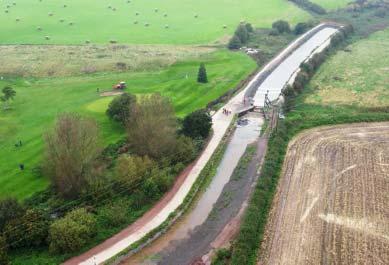
The Manchester Bolton & Bury restoration has been making good progress lately, It’s about to get one of its major problems (a disastrous breach which closed it in the 1930s) dealt with thanks to a housing scheme, and there are more developments on the horizon which look set to extend restoration further. But one waterside development scheme in Salford looks rather less helpful. Yes, it’s reserving a space for future restoration of the canal, but (unlike the one that’s repairing the breach, and the one I mentioned earlier on the Ashby), it isn’t going to reinstate the canal. No, that’ll have to be done later, with funding found from somewhere, once the residents have moved in. They’ll love that. Oh, and a historic parapet wall that’s a remnant of an old canal bridge is to be demolished.
And who’s the developer? H2O Urban - a partnership that CRT is part of. And CRT’s finances are so tight that it can’t afford to make proper provision for a canal in one of its own schemes.
So perhaps, in a way, by putting in our objections to this scheme, we really are robbing the national network to fund our restoration projects? No, I still think that’s an extreme view. But it’s a sign that things are going to be tight in some areas of canal restoration until (we all hope) some way can be found to put CRT’s finances on a less dire footing.
On which subject, to end on a positive note, I’ll remind you that we’re due a general election in 2024, which (whatever the result) might just result in a re-think of Defra and CRT’s deal.
Have a Happy New Year!
Martin Ludgate (*) or as Defra would say, outstandingly generous
This is the point in the year where (very nearly always) the current edition of Navvies contains a Canal Camps schedule for the following year. As you will see from Martin’s article on page 10 this edition very nearly managed to complete that legacy. Because we really do have a decent schedule for 2024 and are just completing those tiny but often significant details. But, if we have learnt anything over the last 50 plus years, it is that to take a gamble on something is rather foolish.
“Aha”, I hear you say, “but haven’t we often taken a gamble on things?” Although there may be some that would not, surely most people with memories that long would agree that (say) Over Basin on the Herefordshire & Gloucestershire Canal, the Droitwich and Huddersfield Canals and many of our other projects certainly have seemed like gambles!
So how can I resolve those two conflicting viewpoints/approaches? Well, having been involved in WRG for a few decades I reckon it all comes down to one word – “belief”.
Because, if there is one common theme amongst everyone I have met on our sites, it is the belief that waterways are worth recovering. That they offer great things to the whole of the UK, whether those things are heritage, environment, economic, education, wellbeing or whatever. And make no mistake about it: that is what drives WRG –a belief in waterways. However, perhaps there is one thing that ‘tempers’ that belief: a belief that, because we believe in waterways so greatly, waterway restoration should be done well. There is a phrase I’ve used for many years now that I seem to remember I first heard in a pub in Oswestry – “the only thing that prevents a good restoration is a bad one”. Because they can build a motorway
across the line, or withdraw funding, or enact any inconvenient law. However as history shows that doesn’t prevent the restoration – it just delays it. But restore a waterway badly, and I suggest that it’s like that for keeps. It’s unlikely anybody is going to say “thanks for that, here’s some more cash can you have another go?” And that approach flows into the planning of our events – if we can’t be confident they will go well then we wait until we can be sure.
Have I really just taken over 350 words to get to “Waterway Recovery Group believes in waterway recovery done well”?
Well to be honest I’d be content with that alone – all organisations benefit from a statement of the bleeding obvious every now and then. But I have just been given a preliminary peek at the returns from WRG’s parent body the Inland Waterways Association’s members survey. Whilst a proper analysis of the returns will be completed and released soon, I think it’s acceptable to say there were plenty of expressions of support for WRG in there.
Anyway – that’s enough navel gazing. Enjoy reading Martin’s excellent preview article and start to think where you might go in 2024.
Mike Palmer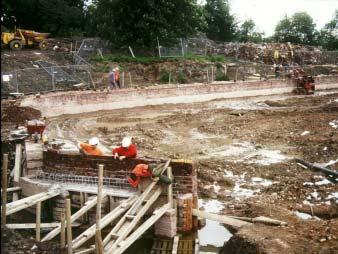
“A gamble”? Over Basin, Herefordshire & Gloucestershire Canal, 2000
Looking through the last edition of Navvies, (Issue 321), I noticed at least three references to the Northern Canals Association and thought that I had better explain, to those that had never heard of us, who the NCA are.
The Northern Canals Association is an independent ‘informal meeting place for waterway restoration’, for groups originally north of Birmingham, but now north of the Lizard (*) as sadly, the Southern Canals Association folded some years ago.
Formed in 1991, its main purpose is to arrange two or three meetings during the year, when restoration groups and others, can meet, chat, have lunch, visit the host’s waterway site, have a couple of speakers relating to their local needs and if possible, some practical experiences. Over the past years visits have been made to places such as Huddersfield, Manchester, Sleaford, Louth, Lichfield, Anderton, Bradley, Foxton, Pocklington and Bugsworth. There have been talks, workshops, lime mortar courses and machinery displays.
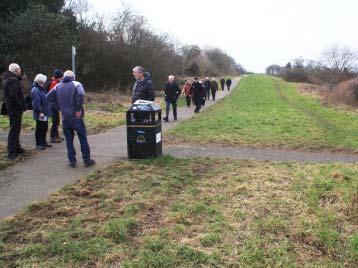
“They’re
At the moment the NCA has 135 members representing 60 different organisations. We are also able to put societies in touch with each other - should they have any special mutual problems with their waterway - e.g. lining to prevent leaks.
Our most recent meeting, in October, was at Radcliffe near Bury, with the Manchester Bolton and Bury Canal Society. For 2024, on Sunday 17th March we plan to be with the Lichfield & Hatherton Canal Trust and on 6th October with the Shropshire Union Canal S ociety on the Montgomery Canal. For 2025 Cromford and the Shrewsbury & Newport groups are taking on as hosts for their days. The meetings are open to all with an interest in waterway restoration, whether as an individual or group. To be added to our mailing list, please contact Ivan Cane at northern.canals2021@btinternet.com
I would like to correct one comment in the last Navvies where the SUCS (p39) said that they had received a grant from the NCA. In fact, the grant was from the late David Tomlinson’s ‘Weeping Cross Fund’. The NCA were just the enabler, as much as we wish we had enough money to provide grants!
Hope to see you at Lichfield in March.
Ivan Cane, Chair NCA
(*) Southernmost point in the UK. But you knew that, didn’t you? ...Ed
Bookings will open soon for the BCN Clean Up, then there’s the Leader Training
Dec-1 Jan
As we went to press, the first WRG Christmas Canal Camp since pre-Pandemic was already looking pretty fully booked, but if you do want to spend a week scrub-bashing on the Buckingham Canal it’s worth checking just in case there have been any cancellations and there’s room for a last-minute booking. But otherwise there’s always the...
Dec-1 Jan
This event is being hosted by Rachael Banyard at Dauntsey Lock, is run by our WRG BITM regional group, but is open to all. If you’re interested contact Dave Wedd on 07816-175454 or email dave.wedd@wrgbitm.org.uk
We now have an agreed site for the annual weekend of throwing grappling hooks into the murky waters of the lesser-used parts of the Birmingham Canal Navigations network and pulling out old bikes, prams, shopping trolleys and who knows what else! The Canal & River Trust team have asked us to return to the Wyrley and Essington Canal, working through Wednesfield to the BCN Main Line in Wolverhampton, using Minerva Wharf as our worksite base as we did a few years ago. This means that there may be a change of accommodation from our regular home of the last few years at the Malthouse at Tipton - we’ll have more details in the next issue. One definite change will be our camp cook, as Maria Hearnden retired at our last event after many years supporting us, so we need a new cook! We’d love to hear from you if you have the experience to cater for between 40 to 60 persons for two days including lunch. Maria has offered to give advice to any prospective volunteers too!!
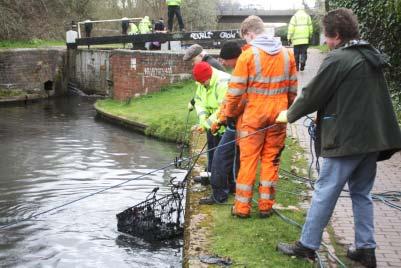
This will be a centrally booked weekend, with booking available via wrg.org.uk, contact enquiries@wrg.org.uk or 01494 783453 for more - or to volunteer your services as cook! Many thanks and fingers crossed.
Chris Morgan
Day, Canalway Cavalcade, WRG Training Weekend... and a load of Canal camps...
As usual the organisers of the Inland Waterways Association’s popular and colourful annual May Day bank holiday weekend festival in London’s Little Venice will be looking for old hands and new volunteers to help set things up, provide site services during the event, and take it down afterwards. We’ll have more details in the next issue.
WRG will be running its annual day of hints, tips, help and advice for existing leaders / assistants / cooks on Canal Camps or working weekends, and anyone who thinks they might want to try their hand at it. More in the next issue.
Get trained up with those skills that you need for your summer camp. Details next time.
And then... a whole summer of Canal Camps...
Turn over the page for our eight-page preview of all the sites we’re heading for in 2024! And look out for the full programme with dates list on wrg.org.uk very shortly.
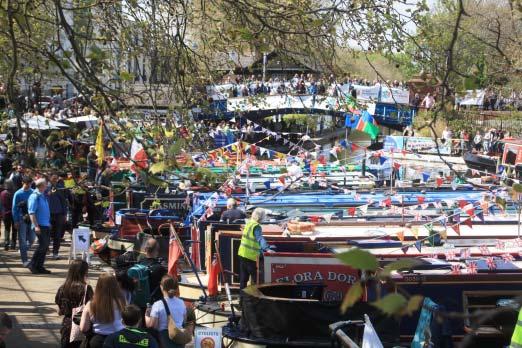
As this Navvies goes to press, we are within weeks of confirming our 2024 programme of week-long Canal Camps. Here’s a sneak preview...
“So has WRG got a great programme of week-long Canal Camps all ready to go?” we asked in issue 316, exactly a year ago. Unfortunately we then said that the short answer was “no”, but we hoped to have one by the following issue in two months’ time. We followed this with a rather longer ‘answer’ consisting of a preview of seven sites that we were expecting to visit, and four more that we might. It will not have escaped the more observant of you that ultimately, for a variety of reasons, we only actually visited four of them in total.
This time it’s different! We are much, much closer to putting the finishing touches on the 2024 programme as we go to press. We have almost finalised the details of sites and work, and have begun assembling them into a schedule. This will be on wrg.org.uk in the near future, but in the meantime here are details of a dozen sites that really will almost certainly be hosting us in 2024 on weeklong Canal Camps booked through the website, or in one or two cases possibly as an ad-hoc working party with volunteers recruited via Navvies...
The Canal Camp work: A machinery oriented Camp welcoming experienced dumper and excavator operators to create a ‘flood storage compensation area’ by the River Erewash near the canal’s route at Beggarlee. And possibly starting construction of a new section of the canal channel and towpath.


The reason: The original route of the canal has been lost under the A610 main road, so a new route will be created, crossing the road via an old railway bridge.
The Canal Camp work: Clearing small trees and other vegetation from the dry bed of the canal at Stainton, then clearing away 50-250mm of soil to uncover the clay lining of the canal. Also clearance of branches overhanging the towpath, biodiversity work including installation of bird boxes and habitat piles, and fencing work.
The reason: Having completed its ‘First Furlong’ project to rewater 200 metres of dry canal from Stainton towards Kendal, Lancaster Canal Trust plans to reinstate the next 360m. But first it needs to find out whether the clay lining will hold water - so it needs to be uncovered, temporarily flooded in sections separated by dams, and tested for leaks.
The restoration: The Canal Trust aims to reopen the northern 14 miles of the canal, abandoned and blocked by the M6 motorway and other new roads built in the 1960s. The first nine miles from Tewitfield to Stainton are still in water, and a trip boat operates at Stainton. By rewatering sections north from there, the Trust can show some physical progress towards its ultimate aim, and in the meantime extend the range of the trip boat operation.
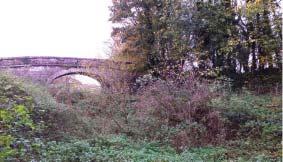

Canal Camp site: Stainton Lancaster Canal northern reaches
Crooklands
Canal blocked by roads at various points
Navigable to Preston 41 miles
But because this new canal route will run across what is designated as floodplain land, there is a requirement to create an alternative area for any floodwater to go - hence the reason for excavating the compensation area. And the spoil excavated from this area will be used to build up the embankment for the new canal channel.
The restoration: The Cromford Canal once stretched for 14 miles from the top of the Erewash Canal at Langley Mill to Cromford. The Friends of the Cromford Canal eventually aim to reopen it all the way through, but there will be several difficult lengths to restore, where the canal is blocked by road and railway crossings, a collapsed tunnel, and sections which have been lost to opencast coal mining. Initially, restoration work has been concentrated on the better preserved sections including the Cromford end, and sections at Ironville and near Ambergate, even though these will remain isolated lengths for some years to come.
But more recently planning permission has been obtained for the current Beggarlee project to reopen the first length from Langley Mill, which will allow visiting boats rom the rest of the waterways network to continue northwards via two new locks which will be built in the coming years. When the initial length is open, the aim is to continue northwards towards Ironville.
See our report on page 22 for more on Beggarlee and the Cromford restoration
The Canal Camp work: Completing rebuilding of John Robinson Lock, following six successful weeks of Canal Camps in 2023. There are still brickwork repairs, coping stone reistatement, lock ladder installation and landscaping to be done - then there’s the previously largely restored Dock Lock to work on.
The reason: These locks are part of the ‘Phase 1b’ length of the Stroudwater Navigation, which is being rebuilt and reopened from Saul Junction to Stonehouse, reconnecting the Cotswold Canals (the Stroudwater and the Thames & Severn Canal) to the national canal network. This work is being supported by a major grant from the National Lottery Heritage Fund. Our work represents an important contribution to the overall project, as well as counting as part of the necessary ‘match funding’ required by the Lottery grant.
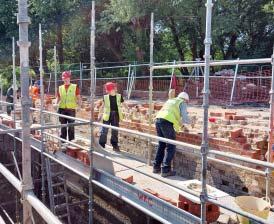
Wey & Arun
Canal
Bramley River Wey to the Thames Shalford
Canal Camp site: Rooks Hill Bridge
Canal Camp site: Bonfire Hanger Summit length
Dunsfold
Compasses Bridge
Restored Loxwood Link section 9
Rowner Lock Mallham Lock Lee Farm Lock
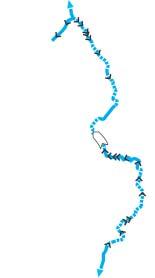
Pallingham Newbridge Birtley bridges Orfold
Tidal River Arun to the coast Loxwood
The Canal Camp work: Laying 950 metres of towpath, using dumpers and excavators.
The reason: The Wey & Arun Canal Trust has just acquired a length of canal and towpath, which leads on from the restored Loxwood Link length, and wants to bring the towpath up to scratch to match the existing sections.
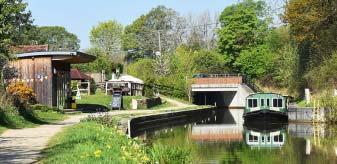
The Canal Camp work: Building a concrete channel to carry the canal over a culvert by the rebuilt Weymoor Bridge, including formwork, reinforcement, and casting the concrete.
The reason: A stream crosses the canal via a channel cut through the canal bed. Before the canal can be reopened, this stream needs diverting to run in the new culvert.
The restoration: Cotswold Canals Trust aims to reopen the route from the Thames at Inglesham to the Gloucester & Sharpness Canal at Saul, with a phased approach. Phase 1a from Stonehouse to Brimscombe is largely complete; work is in hand on Phase 1b to re-connect this to the canal system at Saul. Phase 2 will restore the east end from Inglesham to the Cotswold Water Park (including Weymoor Bridge) Finally, Phase 3 will tackle the difficult central section from the Water Park to Brimscombe.
Phase 1b: Saul to Stonehouse
Camp site: John Robinson Lock

Phase 1a: Stonehouse to Brimscombe
Phase 3: Brimscombe to Water Park
The Canal Camp work: Starting on a project to build a brand new traditional style brick arch bridleway bridge (and later a new lock), including creating formwork, reinforcing, pouring concrete, bricklaying and machinery work.
The reason: Following completion of the two new lift bridges and restored canal at Birtley (see article, page 34), the Wey & Arun Canal Trust is keen to extend this section southwards. The new lock and bridge (replacing missing structures) represent a major step in this direction.
Phase 2: Inglesham to Water Park
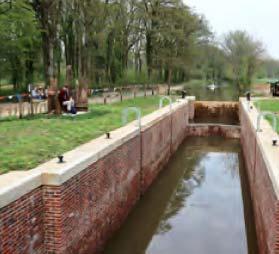
The restoration: The Wey & Arun Canal Trust aims to reopen the entire through route from the River Wey Navigation above Guildford to the River Arun and the South Coast. Several significant lengths have been completed, including the Loxwood Link length of around three miles and five locks plus shorter sections from Malham to Newbridge, on the summit at Dunsfold and elsewhere. Both of the projects supported by 2024 Canal Camps will be helping to close the gaps between these existing restored sections.
The Canal Camp work: Following on from our successful Canal Camp in 2023, continuing the repair and restoration of the walls of Ticklepenny Lock.
The reason: The historic lock, built to an unusual pattern with scalloped walls, had deteriorated to the point where it was in danger of collapse. Our work will prevent further deterioration and preserve it for possible future reopening.
The restoration: The Louth Navigation was partly built as a river-based navigation which follows the River Lud downstream from Louth town, then as an artificial canal heading north to Tetney Haven at the mouth of the Humber. It survived as a drainage channel but the locks fell into dereliction; however since 1986 the Louth Navigation Trust has been dedicated to preserving the waterway and encouraging regeneration of the canal corridor. It has renovated the historic warehouse at Canal Head and holds events there, has published walk leaflets covering the waterway, and ultimately hopes to restore the locks and reopen the waterway to navigation.
The Canal Camp work: Rebuilding a ‘bullnose’ - a semicircular wall which forms the inside of a tight bend at Nob End where boats from Manchester turned sharp left to enter the Bolton branch of the canal. It will include bricklaying, blockwork, casting concrete ‘stones’ to replace missing coping stones, concrete backfilling and landscaping.
The reason: This section of canal
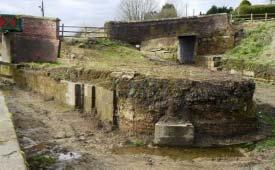
has been closed since a disastrous burst in 1936, when a nearby length of canal, where it runs high on the steep valley side, collapsed into the River Irwell. Manchester Bolton & Bury Canal Society saw it as a major obstruction to restoration. But recently, in what has been called “the most important thing to happen in many years” a housing development has been approved which (as part of its planning permission) will pay to repair the breach and reinstate 700 metres of canal. And this bullnose wall needs to be rebuilt to facilitate that reinstatement.
The restoration: The Canal Society hopes to reopen the entire route, but faces some challenges. However with the breach repaired, there is the potential to reopen five miles from Radcliffe to Nob End and on towards Bolton. This could then be extended towards Bury, and also down the six locks leading south from the junction, reducing the gap between there and a restored length at the Manchester end, bringing complete reopening closer.
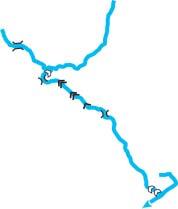
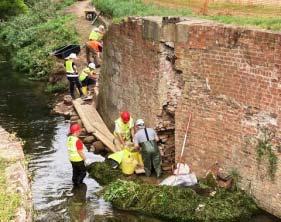
Canal
Louth
Navigation
Tetney
Humber Estuary
Tetney Lock
Sand and mud
Marshchapel
North Sea North Somercoates
Saltfleet
Outfen Lock
Salterfen AlvinghamLockLock
Willows Lock
Keddington Lock
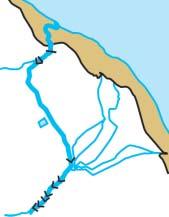
Town Lock River Lud
Canal Camp site: Ticklepenny Lock
The Canal Camp work: Finishing off works at the new Schoolhouse Bridge, including removing a temporary road which carried traffic while the bridge was under construction.
The reason: Following the 2023 reopening of a newly restored length of canal to Crickheath Wharf, attention has shifted to the next section south. Plans are under way for channel lining, the new bridge has removed the last major obstruction on the English side of the border, and any work we do will help get the canal open through into Wales.
The restoration: After over 50 years’ work, more than half of the canal is already open including a continuous 12-mile Welsh length from Arddleen through Welshpool to Refail. Major Government grants are helping to support further work on the Welsh section, and there are good prospects for connecting this up to the English length at Llanymynech in the not too distant future. Completion south to Newtown could then follow on.
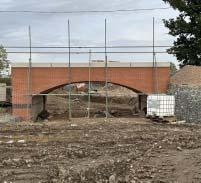
Montgomery Canal
Reopened in stages Frankton to Crickheath 1996-2023
Llangollen Canal Frankton

Newtown
Canal Camp site: Schoolhouse Bridge
Major Government funded work in progress from Welsh border to Arddleen
Reopened in stages Arddleen to Refail 1970s-2000
3 locks restored but blockages remain south of Refail. Final length to Newtown obstructed
The Canal Camp work: Completing the task we began during last year’s Canal Camp, to build an access ramp connecting an original brick bridge to the towpath.
The reason: To provide public access from the popular Selly Oak Park to the towpath of a length of canal which Lapal Canal Trust is currently working to reopen as a short branch off the Worcester & Birmingham Canal leading into the park.
The restoration: The Lapal Canal is the name given by canal restorers to the abandoned length of the Dudley No 2 Canal, which was built as a bypass route around Birmingham, but suffered
The Canal Camp work: Clearing 100 metres of trees and dense scrub from the bed of the abandoned length of the Dudley No 2 Canal beyond Coombeswood Basin.
Gosty Hill Tunnel
Dudley No 2 Canal navigable to Coombeswood
Coombeswood Canal Camp site
Coombeswood (or Hawne) Basin
Leasowes Halesowen
Lapal Tunnel (collapsed) To Stourbridge Windmill End
Lapal Canal Camp site: Selly Oak
Proposed diversion with new locks
California
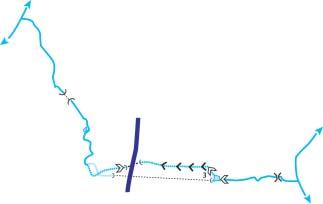
...and Coombeswood
To Worcester
The reason: This will be the first step towards clearing the channel, towpath and towpath wall of this length to investigate its state, with a view to reopening it to navigation.

The restoration: This is the opposite end of the same abandoned section of the Dudley No 2 Canal that the Lapal Canal Trust (see above) are working on, also became derelict following the collapse of Lapal Tunnel and ending of local trade, and could one day also form part of the same restored through route.
In the 1990s some restoration work was carried out on the disused length where it runs through the attractive Leasowes Park, about half a mile beyond Coombeswood Basin (the current limit of navigation and base for Coombeswood Canal Trust). However with work since then concentrated elsewhere, Coombeswood Canal Trust is developing a scheme to work on reopening the canal from Coombeswood towards Leasowes.
from mining subsidence affecting the very long Lapal Tunnel, which eventually collapsed and closed the route.
The Trust’s long-term aim is to reopen it via a new route with locks climbing over the hill rather than repair the tunnel. However in the shorter term the goal is to open the east end as a local amenity and an attractive detour off the Worcester & Birmingham Canalstarting with the current project at Selly Oak Park.

On the preceding seven pages you’ve read about all the waterway restoration projects whose proposals to host WRG Canal Camps have (at time of going to press) reached the stage where we can be pretty confident that they will feature in the final programme (usual disclaimers apply!)
However there are several ‘bubbling under’ proposals that haven’t quite made it that far (for example because they are awaiting permissions), but which might well get into the programme, or at least as far as ‘unofficial’ camps (advertised through Navvies but not listed as part of the main programme), or be sites for mobile groups’ weekend digs. They include...
Lichfield Canal: Lichfield & Hatherton Canals Restoration Trust has some very interesting projects coming up including building new locks where the canal is being diverted alongside the Lichfield Bypass and also where it needs to pass under Cricket Lane.
Neath Canal: Various possible projects on the previously restored length from Resolven up towards Glyn Neath.
Buckingham Canal: Following on from the reopening of the rebuilt Bridge 1 and the first length of restored canal beyond (see Navvies 321) the Buckingham Canal Society is keen to continue with the next section - subject to planning applications and neighbouring developments.
River Stour (the Essex / Suffolk one): Possibilities include various public access projects such as landing stages, benches, picnic sites, fishing platforms, tree clearing
Wilts & Berks Canal: Possible bank stabilisation work
We hope to have details of any or all of these as they reach the point where we can add them to the ‘definites’ list
Watch this space...
Gordon Brown reports back from WRG’s specialist Forestry Team’s weeklong Canal Camp felling ash trees on the Wey & Arun Canal in October
This year’s WRG Forestry Canal Camp took place on the Wey & Arun Canal, with work at three sites to fell and remove trees affected by Ash Die-Back. As is customary in Forestry, the camp started on the Friday night, with a hearty meal in the Onslow Arms in Loxwood ready to make a start on Saturday morning… …which dawned wet. Very wet. So wet in fact that we were within moments of going back to the hall when the sun came out. And stayed out. Conscious of keeping the neighbours happy, site access was restricted so as not to churn up the fields too much, especially as we were using a couple of fairly large tracked excavators, so a lengthy canal-side walk was involved (tip: don’t leave your waterproofs in the car park). A few healthy showers of rain meant frequent short breaks for cover, and an impressive number of rainbows appearing across the field. We idly wondered what a rainbow weighs before concluding they are pretty light. Sorry.
As the Wey & Arun Canal Trust sells the timber, the trees were felled to a strict specification in terms of length and minimum diameter and carefully snedded (side branches trimmed off). Brash and under-sized wood was burnt on site with the main lengths carefully stacked for collection later.
By Tuesday, that site was finished and we moved a short distance along the canal to another stretch needing clearing. Again technical
felling was required, with the excavators being used to extract felled timber from the cut, transport and stack it. Again undersized wood and brash was burnt, and this was to be our base for the rest of the week, except for Wednesday when a small group headed to a recently acquired stretch of the canal at the aptly named Bonfire Hanger (no fires allowed!) which needed a number of trees to be felled for processing by local volunteers. Unfortunately the arrangement of the trees to be felled, combined with the narrow confines of the canal and tow path, restricted the amount of work that could be completed by the team, but a few trees were felled successfully including a few winch-assisted fells, for local volunteers to process. The remaining trees will require dismantling in sections, which is a job for another time. Also on Wednesday the team took a break to visit a local timber contractor to see some of the specialist pieces of forestry plant they use, and for them to explain some of the technology in new machines that measure the wood and calculate where to cut to get the best value from it, all in the time it would take us just to get the tape measure out of our pockets.

The rest of the week followed a familiar pattern, with most diseased ash trees being felled and processed, before on Friday a contractor arrived to begin the task of removing the stacks of timber we had felled and processed. The wood will ultimately be chipped and used as biomass for a power station, and the proceeds from its sale used to further maintain and restore the canal.
Throughout the week we were well fed by Mitch and Tracy, with Clive leading proceedings and (local) Dave Evans of WACT making sure we were all on our toes. A big thank you to the team for achieving a great deal of work, and overall the weather held fair for us. There’s still plenty of work for Forestry on the Wey & Arun, so no doubt we will be back again in the near future.
Gordon Brown Assistant LeaderFor more on the Wey & Arun see pages 12-13 and 34-35
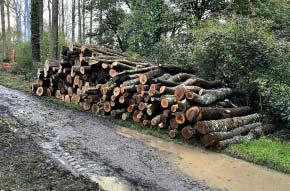

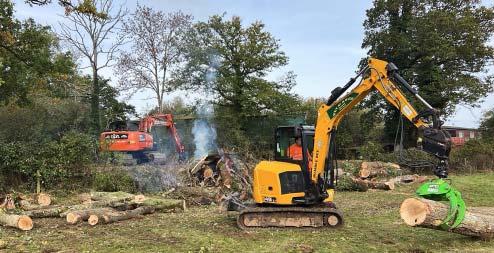
Canals Camps cost £80 per week or as stated. Bookings for WRG Camps with number Court, Asheridge Road, Chesham HP5 2PX. Tel: 01494 783453, enquiries@wrg.org.uk
Dec 26-Jan 1 WRG
Christmas / New Year Canal Camp, Buckingham Canal. Likely to be full
Dec 26-Jan 1 wrgBITM Wilts & Berks Canal: Christmas - New Year Camp with Rachael Banyard
Jan 13-14 London WRG
Chelmer & Blackwater Navigation, Springfield Basin
Jan 20-21 WRG NorthWest Manchester Bolton & Bury Canal
Jan 20-21 wrgBITM Chelmer & Blackwater Navigation: Springfield Basin, clearing trees & scrub from the dredger (to be confirmed)
Feb 3-4 WRG NorthWest Chesterfield Canal (date to be confirmed - could be 10-11 Feb)
Feb 3-4 KESCRG Wey & Arun Canal: scrub clearance
Feb 17-18
London WRG Cotswold Canals, John Robinson Lock
Feb 17-18 wrgBITM Maidenhead Waterways: Bray Cut, removing fallen trees
Mar 2-3 KESCRG Cotswold Canals: probably John Robinson Lock
Mar 16-17 WRG NorthWest Manchester Bolton & Bury Canal
Mar 16-17 WRG/IWA/BCNS BCN Clean Up, Wyrley & Essington Canal: see pages 8-9 for more infor
Mar 16-17 London WRG Supporting BCN Clean Up
Mar 16-17 wrgBITM Chelmer & Blackwater Navigation: Clearing overgrowth and overhanging trees from the bank (to be confirmed)
Apr 13-14 KESCRG Joint working party with London WRG on the Wey & Arun Canal
Apr 13-14
London WRG Joint working party with KESCRG on the Wey & Arun Canal
Apr 20-21 wrgBITM To be arranged
May 1-7 WRG/IWA Canalway Cavalcade festival at Little Venice: team needed to set up, su See next issue for more details
May 11-12 KESCRG To be arranged
May 17-19 wrgBITM Rickmansworth Festival: to be confirmed
May 18 WRG Leader Training Day: see pages 8-9
May 18-19
London WRG Cotswold Canals, John Robinson Lock
Jun 8-9 KESCRG To be arranged
e.g. ‘Camp CC-202302’ should go to WRG Canal Camps, Unit 16B, First Floor, Chiltern . Diary contributions to Dave Wedd, Tel: 07816 175454, dave.wedd@wrgbitm.org.uk
y booked - phone or email to check01494-783453 enquiries@wrg.org.uk
d Dave Wedd 07816-175454 dave.wedd@wrgbitm.org.uk
Tim Lewis 07802-518094 london@wrg.org.uk
Malcolm Bridge 07956 944489 malcolm.bridge@gmail.com
Dave Wedd 07816-175454 dave.wedd@wrgbitm.org.uk
Malcolm Bridge 07956 944489 malcolm.bridge@gmail.com
Ed Walker 07887-568029 ed@edwalker.eclipse.co.uk
Tim Lewis 07802-518094 london@wrg.org.uk
Dave Wedd 07816-175454 dave.wedd@wrgbitm.org.uk
Ed Walker 07887-568029 ed@edwalker.eclipse.co.uk
Malcolm Bridge 07956 944489 malcolm.bridge@gmail.com mation01494-783453 enquiries@wrg.org.uk
Tim Lewis 07802-518094 london@wrg.org.uk
Dave Wedd 07816-175454 dave.wedd@wrgbitm.org.uk
Ed Walker 07887-568029 ed@edwalker.eclipse.co.uk
Tim Lewis 07802-518094 london@wrg.org.uk
Dave Wedd 07816-175454 dave.wedd@wrgbitm.org.uk upport site services and take down
Ed Walker 07887-568029 ed@edwalker.eclipse.co.uk
Dave Wedd 07816-175454 dave.wedd@wrgbitm.org.uk 01494-783453 enquiries@wrg.org.uk
Tim Lewis 07802-518094 london@wrg.org.uk
Ed Walker 07887-568029 ed@edwalker.eclipse.co.uk
A third visit to the Friends of the Cromford Canal’s Beggarlee project with an ad-hoc team of WRG regulars... will they finish the land drainage works?
In issue 320 we brought you the first report from WRG’s involvement in the Friends of the Cromford Canal’s Beggarlee Project , in which a small group of experienced volunteers spent a long weekend getting stuck into the urgent task of getting the land drainage works under way in preparation for a new length of canal to be built. It was an urgent task not because of any particular practical reasons for getting started in a hurry, but because the necessary meetings and discussions with all the relevant bodies (made worse by the site being on a boundary between two counties and two local authorities) had taken so long that there was a danger that the planning permission might expire – resulting in a ‘back to square one’ scenario.
But as well as satisfying the planners, the team did a lot of the work of extending one land drain culvert to pass under the site for the new canal channel, and made a start on a second one.
In issue 321 we reported back from a
second long weekend, a Kescrg-led working party which continued the second culvert, culminating in a big concrete pour to create a large new manhole chamber where the old and new culvert sections meet.
All that was left to do was install the outfall ‘head walls’ on the two culverts (one of them a 600mm plastic pipe, the other a 900mm concrete one), some finishing-off works on the manhole chamber, and some backfilling of the completed culverts, so another weekend in November was scheduled. Pete Fleming, who has led the project from the WRG side (in cooperation with the FCC’s own team of volunteers), takes up the story...
All arrived, unloaded the van of catering kit, and set up beds. A quick trip to the bar next door (one advantage of the Ironville Village Hall is that we’re welcome in the Anvil Club bar that shares the building – there’s even a ‘short cut’ door straight through!), I think we arrived after their published opening hours but still left before many of the other occupants did and we have no idea what time they did actually close.
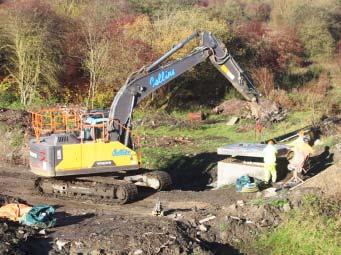
We had slightly reduced numbers for this weekend, due to scope of the work being decreased from the original plan owing to the wet weather in previous weeks, which would have made the backfilling activity impossible to complete effectively.
Friday
John cooked breakfast for just before 8:00 which we were just tucking into when we got a phone call to say the lorry with the
precast concrete head wall units was ten miles away. We arrived onto site to find the lorry with the large lumps of concrete ready for us to offload which we did successfully and got the lorry on his way just before Travis Perkins arrived with a pallet of sand, cement and a manhole cover. The manhole cover wasn’t the right one – we had sent an identical one back the previous weekend we had been here as it was too small.
David started putting together the ladder that would go in the manhole chamber built on the previous visit.
Adrian started clearing the existing ditch that the two culverts empty into, and regrading this so that the water would flow away to a lower level, with local Ian dumpering the wet spoil away.
A worrying issue occurred with the Burco and being unable to light it however it was found that not 1 but 2 of the 3 gas bottles we had were lacking in gas!
Martin started clearing around the end of the 600mm plastic pipe to allow the joining collar to be fitted. It was a case of ‘1 spade full dug out, 20 more spade fulls coming down’ due to the angle of repose of the pipe bedding gravel.
Pumps were setup to drain the working area where the head walls would be installed, while John filled a number of sandbags that were then used after the water level had been reduced to create a tempo-
rary dam in the end of the 900mm pipe with a pump behind. This kept pace with the water coming down the pipe and enabled the other two pumps to more effectively clear the ground water that was seeping into the working area.
The joiner was fitted to the 600mm pipe with some assistance of the excavator to push it finally home over the rubber seal.
David drilled and prepared the holes in the concrete chamber to fit the ladder.
Dave (FCC chairman) arrived with the correct manhole cover! This was after local John had been to another TP branch and collected another wrong cover.
After lunch the bolts for the ladder were resin fixed into place and the ladder fitted into place. A surprising number of bricks and large stones were removed from the chamber, which had been washed down the pipe by the flow of water.
The area at the end of the 900mm pipe for the headwall was measured out and some further excavation done on this.
The pumps were stripped down and all tools and equipment packed away ready for leaving site at 4pm just before it got dark.
Martin went off on the hunt to refill the gas bottles and was eventually successful. Pasta bolognaise and garlic bread for dinner! A few of us adjourned to the bar where there was a strange musical bingo game happening. All in bed by 11:00pm.
The project for the working party: Finishing-off works to new pipe culverts at Begg arlee, Langley Mill, to extend existing land drainage r unning under the A610 road embankment
Why? To replace existing drainage ditches with pipes laid deep enough that the new canal channel can be built above them as part of the Beggarlee Project - see next page.
Length: 14½ miles
Locks: 14
Date closed: 1900-1944
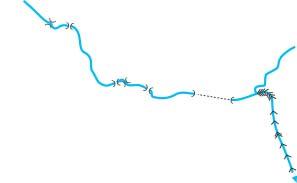
The wider picture: The Friends hope eventually to reopen the entire canal through from Langley Mill to Cromford. There are difficulties including the missing Bull Bridge Aqueduct (over the main road and railway) near Ambergate, the collapsed Butterley Tunnel and the need to work sensitively in par tnership with wildlife groups. However there is a restored length with trip-boat from Cromford to High Peak Junction, and work has been carried out at other sites includin Sawmills and the Pinxton Arm.The Beggarlee Project will open up of the southern length extending north from Langley Mill (head of the Erewash Canal and a link to the national waterways network). It will represent a major step forward towards full restoration by putting the Cromford back on the waterways map.
Saturday
Another breakfast by John H which included non-egg eggy bread. No interruptions with phone calls about deliveries today. Had to de-ice the van following a good frost overnight before arriving on site at dead-on 9:00. Pumps were set-up to start emptying the headwall area of water while David tightened his nuts on the ladder fixings. The mixer was set up and a mix of mortar was done and spread around the top of the chamber walls. The cover slab (weighing 3.3 tonnes) was slung and lifted with the excavator over to the chamber and fitted with only one minor realignment required. The work was enlivened by a large black and white cat stalking the team! The joint was pointed up and the cover frame fitted on a bed of mortar. A rather generous mix of concrete was made and this was used to haunch around the frame to ensure it is well secured to the cover slab and hopefully reduce the risk of it being dislodged by the local oiks.
After a pause at 11:00 and a brew, the team moved on to the headwall for the 900mm pipe. The pumps were repositioned to allow clear access for the final excavation, which included some done by hand around
and under the end of the pipe. Various measurements were taken of the headwall and these checked against the hole before the layer of bedding stone was placed and spread as required. A final dimension check was done before the headwall unit (3.7 tonned) was lifted by the excavator and lowered into position, fitting over the end of the pipe and into position on the first attempt. Some very minor adjustments were made to the position before extra bedding stone was packed around it and the chains removed allowing the team to go for a late lunch at 2:00pm.
The rest of the afternoon was spent digging out the location for the second headwall which would fit around the 600mm pipe. The position of the pipe means that some further work will be required to connect the pipe and the headwall. By the end of the day the bulk excavation had been completed and things prepared for the final excavation and subsequent precast installation. We left site again at 16:00.
Fish and chips for dinner with everyone tired from the successful days work. We had just got enough energy together to go next door to the bar for a drink, to find it with a note on the door apologising for having to
The Beggarlee Project will reopen the first 1.25km of the Cromford Canal northwards from Langley Mill, terminus of the Erewash Canal. This is not an easy length to restore as it was blocked in the 1980s by the construction of the new A610 Langley Mill bypass road.
Creating a new navigable culvert to carry the restored canal through the road embankment on the original route would be prohibitively expensive and difficult, but an alternative exists in the form of a bridge which was built to carry the road over a freight railway siding which served a coal mine. The mine closed not long after the road was completed, but the unused bridge still stands and can be used to carry a diverted canal. However this is not a straightforward job, for several reasons. Firstly the siding ran east-west while the canal runs north-south, so the new channel will need two very sharp bends. Secondly the bridge wasn’t built to carry the weight of a waterway on its foundations, and thirdly it’s at an awkward height relative to the canal. The solution to these latter two issues is to build a pair of staircase locks (replacing two single locks on the original route) to raise the canal to a level such that it can then be carried through the old railway siding bridge on an ‘aqueduct’ structure suppor ted by abutments on either side of the bridge, rather than putting any of its weight on the bridge foundations.

Site for winding hole and end of initial Begqarlee project
Original canal route blocked by A610 embankment
Planned canal diversion using old railway siding bridge
close early that evening! We had thought it was a bit quiet. So we drank a few of the beers we had brought with us before retiring to bed by 10:30!
So the brief notes made on Saturday evening for the plan went along the lines of “Breakfast, pack kit and clear hall, setup pumps and pump out, final excavation, place bedding stone, place headwall, pack site kit, go home!”
The day started well with everyone being awake early and John calling breakfast around 7:45, after which the packing of the remaining kit was completed and tidying the hall commenced. During tidying the hall, Adrian received a phone call from the locals who were struggling to start the excavator, after a few suggestions of things to try it still wouldn’t start so awaited our arrival at about 9:15.
Once we had arrived on site, Adrian tried starting the machine whilst the rest of us setup the pumps and started pumping down the water in preparation. After Adrian couldn’t get the machine started the call was
made to the hire company as well as local John visiting his neighbour (the hire company owner) to get their on-call engineer out to fix it.
Measurements of the headwall were taken and roughly marked out in the excavated hole to determine what else needed excavating.
Some levels were taken of the pipes installed previously and also the final water level of the canal marked up on the road bridge piers. This gives a far better understanding of the task ahead on this site with the volume of material required to bring the ground up to the required level.
After several tea breaks, local John was still struggling to get hold of the hire company engineer. We cleaned down any kit that wasn’t being used or would be needed until at 12:00 the hire company confirmed they couldn’t get their engineer out that day.
Without the excavator there was nothing more the team could do on site, so we cleaned up the kit the best we could before having lunch and departing home, frustrated that we couldn’t quite finish the job we had come to do.
Pete Fleming
First headwall in place and level. Sadly, plant problems meant the second one will have to wait
Will the Crickheath South length hold water? Shropshire Union Canal Society gets its test results. Plus there’s a story of a horse tramway...
The Shropshire Gap has become the colloquial term for the unrestored section of the Montgomery Canal between Crickheath Basin (which since its reopening in 2023 has been the limit of navigation of the restored and reopened section from the Llangollen Canal at Frankton Junction) and the short restored trip-boat length at Llanymynech on the Welsh border. But the gap is steadily diminishing as work continues at Crickheath South and Schoolhouse Bridge. This work has been helped in no small part by public donations and volunteers from the Shropshire Union Canal Society (SUCS) working at Crickheath South, but recently funds have been bolstered by several grants. Tom Fulda, project manager for SUCS, explains…
The grant of £14,600 from The Association of Industrial Archaeology has been widely reported and work on the Tramway Wharf wall is well underway with help from members of the Dry Stone Wall Association who are bringing their expertise to the project.
The National Grid Electricity Distribution awarded a grant of £7,351 to the Montgomery Waterway Restoration Trust from their Community Matters Fund for environmental improvements, and work on the 320 metres of Towpath, being built by our volunteers from SUCS, is nearly complete with the scheduled 75 metres of tree
planting to follow. Oswestry Rural Council has also given money to help with the improvements of the towpath and there has already been a marked increase in footfall. Weeping Cross is a charitable organisation set up in the 1960s to support the restoration and conservation of historic industrial sites and they have donated £1,000 for tools that are now at work on the project.
And finally, the Postcode Lottery have given a grant of £17,000 from their Local Trust for Community Projects to help the canal reach Schoolhouse Bridge. We are so grateful to all these organisations for their help and support as we beaver away, restoring the Tramway Wharf wall, the channel from Crickheath Bridge to Schoolhouse Bridge and of course, the towpath, which is coming on in leaps and bounds. We’ve had so many positive comments from passersby as they enjoy the beautiful rural landscape and hopeful boaters, who can’t wait to cruise down to Schoolhouse Bridge and beyond. I would encourage everyone to come and have a look at the work that’s going on – it’s a great local endeavour.

Now we’ll hear in detail about the progress on recent SUCS working parties on the ‘Crickheath South’ project, restoring the currently dry canal channel southwards from Crickheath as far as the next objective of Schoolhouse Bridge. This section has been divided into Phase 1 (in the Crickheath area) and Phase 2 (at the Schoolhouse Bridge end); Phase 1 has been futher subdivided into Phase 1A and Phase 1B…
South work party
As has been the case for so many of the work parties this year, a great variety of different tasks were undertaken and, once again, major milestones achieved.
Milestone 1: the water test is underway! This involves setting up two water test areas in the Phase 1A and Phase 1B sections of canal to see if these lengths of canal channel south of Crickheath will need to be lined before it can be rewatered. It wasn’t lined when originally built in the 1790s; however the section north of Crickheath has had to be completely relined, and this represented a large part of the work to reopen this length.
On this occasion, the work party took place over four days with a handful of volunteers also attending on Thursday to help with the set-up. The day started with delivery of the large pump and associated pipework. This was positioned by Crickheath Bridge with kind permission to locate it in the garden of Pear Tree Cottage. Water is supplied from Crickheath Basin and pumped along the offside bank above the wharf wall to the two test areas, a distance of approximately 240m to the furthest. The testing will inform decisions on what waterproofing will be required and where (if any). By Thursday afternoon, pumping had started.
Several top-ups were planned over the following week or so, and close inspection of the site would be undertaken each day. It has already been established that some form of waterproofing will be required in the Phase 1B section. Based on the test results, the Canal & River Trust will confirm the final design and specification over winter and channel works will commence during 2024.
Milestone 2: towpath works for the Phase 1B section completed! Fantastic progress was made over all three days of the regular Friday to Sunday work party. A couple of access points have been incorporated into the towpath to allow for movement of plant and materials when channel works commence. This work is funded by a grant from the National Grid Community Fund. The grant also funds further environmental improvements with tree and hedge planting which will be completed over the next couple of work parties.
Milestone 3: Crickheath Bridge wash wall (canal channel wall) completed! The wall was in a rather dilapidated state. It was repairable for the most part, though the southern end required rebuilding. The wash wall extends 25 metres south from the bridge on the towpath side and has been repaired using a lime-based mortar.
Further substantial progress has been made with repairs to the wharf wall thanks to the sterling efforts of John, Mike and Imogen of the Dry Stone Walling Association with assistance along the way from the Society’s volunteers. Most of the wall is now ready for final adjustment before replacing the existing copings which all have some variation in dimensions. Conditions permit-

Completed length of towpath
ting, this will start next work party. The new coping stones funded by the Association for Industrial Archaeology will be placed next year.
Other activities undertaken were inspection and vegetation clearance around the hedging whips planted in the spring – all doing well, weeding and tidying in the compound area and moving material to the bonfire site by the stump for the next burnup. No doubt there’ll be a ‘stump update’ in a future report.
Once again, a great work party.
Shropshire has supposedly had the wettest October for 120 years. But unlike Canute, we just about succeeded in holding back the water during this month’s work party.
The channel in Phase 1A typically starts filling with water in December or January. Not so this year. But thanks to pumping during the week before and throughout the work party, first with one, then two and eventually three pumps, we managed to
You will have seen a few mentions of restoration of a tramway wharf in the Montgomery Canal progress reports on these pages. By way of an explanation…
The tramway wharf at Crickheath was the terminus of a ‘tramway’, an early mineral railway. It was built by the Earl of Powys in around 1797 was originally known as the Porthywaen Iron Railway and (as was the norm in that era before the invention of the steam locomotive) was horse-drawn. It was established to take advantage of the newly built canal to move limestone from the quarries at Porthywaen and nearby Whitehaven to the wharf at Crickheath for further transit. The route ran g enerally westwards from Crickheath to cross both the Oswestry to Welshpool turnpike road, now the A483 and the Llynclys to Porthywaen Road, now the B4396, continuing west to the limestone quarries where it split into two short branches.
In 1860 the Oswestry & Newtown Railway (Later the Cambrian Railway) was opened to Pool Quay, and a bridge to carry the tramway over the railway was built near Llynclys Station, next to the road bridge for the Knockin Road, the B4396. (The abutments of this bridge can still be seen from the Cambrian Heritage Railway station.) A branch line from the railway was later built to Porthywaen and over the next 40 years or so the infrastructure varied no end as quarry working changed, but it seems that both the tramway and the railway coe xisted happily tog ether. However the railway always had the upper hand and as maintenance on the canal deteriorated the writing was on the wall.
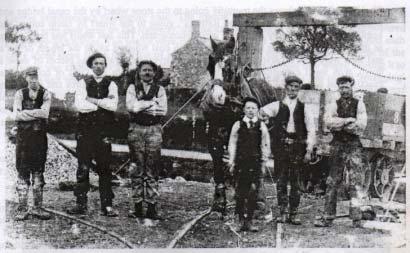
The 1926 maps show the route clearly, although trade had star ted to dwindle by then. The tramway closed when the canal suffered a breach in 1936 which was not repaired and led to the canal’s abandonment; however it is doubtful that there was much activity after 1930 due to AA Peate selling off their fleet of narrowboats at Maesbury Hall Mill. The lines were finally lifted in 1939. Although the end seems a little sad, it is to be remembered that the tramway traded successfully for some 130 years. And the wharf has survived… Built by navvies during the construction of the canal at the end of the 18th century, the tramway wharf is constructed as a wide rubble stone wall using local limestone.
The tramway in 1900
keep this area dry enough for activities to continue. ‘Dry’ would be a misnomer –though more of that later. This report starts with the results of the water testing carried out last month.
Testing continued for six days. As mentioned in the above report from the October working party, the testing in Phase 1B established that some form of waterproofing will be required. After 24 hours of pumping, the water level rose a meagre 19cm, whereas it was estimated that it should take 16-17 hours to completely fill the channel if it was
watertight. Leakage was identified at the base of the embankment and the test was terminated. The Phase 1A test area did hold water. Repairs to the channel bank in August appear to have been successful and there was no leakage past the embankment. The test area was filled three times. The water level dropped over time at approximately the same rate on each occasion, passing beneath the northern dam into the channel towards Crickheath Bridge. The results will be reviewed with CRT and the design and specification finalised with the aim of commencing
The wharf wall is being restored as it was originally built, with members of the Dry Stone Walling Association contributing their expertise to ensure durable and high quality repairs. The wall is topped with large copings of buff and yellow sandstone/gritstone that supported the tramway rails and wagons from where stone was tipped into moored narrowboats. It is thought that even back in the 18th century the copings were repurposed from elsewhere, as there is some variation in materials and different stonemason dressing marks. These marks are interesting as they, once upon a time, identified the person who dressed the stone in the first place; but we don’t know if these marks were for position on the wharf or to guarantee payment to the mason.
Many stones have crumbled and require replacement: traditional skills and methods are being used to great effect at Grinshill Stone Quarry, where masons are dressing a total of over 30 metres of large coping stones to replace broken ones.
The replacement of the broken stones has been supported by a generous £14,600 restoration grant from the Association for Industrial Archaeology, which promotes the study and appreciation of industrial archaeology through a program of awards and grants and promotes its aims through broad engagement with people in their early careers.
Tom Fulda, Shropshire Union Canal Society project manager said, “We are very grateful for this generous grant, it will substantially help the project with the cost of plant hire, volunteer welfare and materials as well as promoting the work of the Association for Industrial Archaeology, which has supported the study, preservation and presentation of many sites since the 70’s. If you live near the Montgomery canal, why not pop down to Crickheath and see the prog ress we’re making?”
Chris Bryan-SmithThe author would like to thank Kenton Owen and the Oswestry Borderland Heritage website for their help and information for this article. See www.oswestryborderland-heritage.co.uk
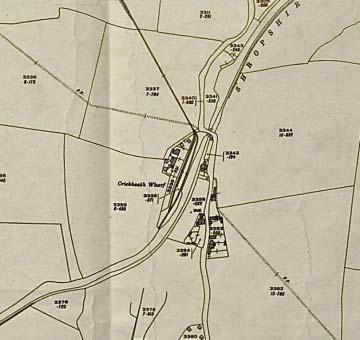
1926 Map of Crickheath Wharf: the canal runs from north east to south west; the tramway can be seen coming in from the north west
channel restoration works early in the new year.
The first job this month was to fully decommission the water tests. This involved removal of three clay dams starting with the two in Phase 1A, thereby re-establishing plant access to the wharf wall area. Removal of the third dam in the Phase 1B test area was completed on Saturday and the area made good. The clay has been stored on site for future use.
Having regained plant access to the wharf wall area on Friday afternoon, the opportunity was taken to clear the site of surplus stone and other materials in readiness for placing coping stones onto the newly-repaired wall. Whilst the ground by the wall itself remained firm, the channel bed turned to deep mud due to the repeated plant movement exacerbated by steady rainfall on Saturday. Thankfully none of the plant got stuck.
Many of the existing coping stones can be reused but a good number have degraded, delaminated and generally disintegrated over the centuries. Replacement natural stone, hand-tooled copings have been sourced, funded by a generous grant from the Association for Industrial Archaeol-
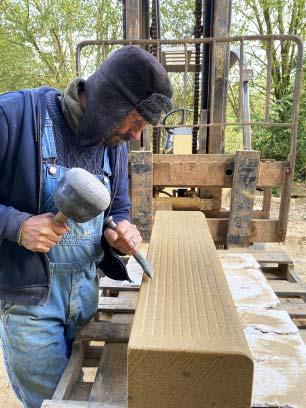

ogy. There are two areas where these will be used. Placing these on top of a dry-stone wall with an uneven surface is a fiddly job but over Saturday and Sunday, one stretch was completed, a length of 12.2 metres. A total of 20 metres of copings have now been placed on the repaired wall. A further 70 metres remains – this will now wait till next year when water levels in this part of the channel once again become manageable. One of several activities planned for the winter is hedgelaying in an area of Phase 2. In preparation for this, a quantity of dead wood (saplings and small trees) was removed from the hedge to the bonfire area and piled around the stump ready for future burning. Completed section of wharf wall
Shrewsbury & Newport Canals Trust’s volunteers continue their work on the historic Wappenshall warehouses, as well as re-filling the restored basin
Wappenshall Wharf Project (restoring the historic warehouses at the junction of the Shrewsbury Canal and Newport Canal as a community centre and canal centre) is really moving forward now. The cast iron windows that were cast by St Gobain Ironworks in Ketley for us have been installed, glazed and painted. First fix plumbing and electrics have been completed and the internal fit-out has begun. This has involved fitting dry wall studding framework and mineral wool insulation, plus plaster-boarding the ceiling and walls.
The Romney Building is going to our partners at Ironbridge Gorge Museum Trust and is planned for dismantling at the end of November. We can then crack on with building the stable block. We have been pumping water into the East Basin from the Hurley Brook for 3 weeks and Storm Babet greatly helped to fill it too!
We were fortunate to have London WRG come to our Uffington Electricity Sub-Station site (near the Shrewsbury end of the canal) at the beginning of October. Working with our volunteers a great deal of work was done to remove some big tree stumps from the canal bank using Tirfor winches and many of the trees previously taken down were processed into logs. These will be sold to boost funds.
Bernie Jones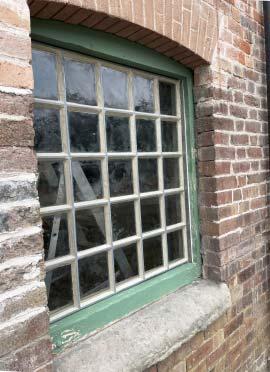
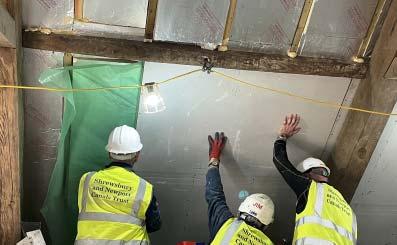
Things are not quite so “dire” as the last report suggested, but the Wooden Canal Boat Society would still welcome more help with its heritage fleet
I think my last report from the WCBS was a bit dire; the Society has certainly been through some difficult times in the last couple of years.
However, the Hazel Wellbeing Boat project kept going throughout. In 2021-22 there was a Lottery funded project concentrating on giving canal breaks for NHS and care workers who had worked through the pandemic. In the early spring of this year Hazel had extensive work on her roof and cabin sides and has carried on with her wellbeing work, though we’re looking for funding to enable us to make this more widely available.
The main victim of the Covid pandemic
was Southam. Having had extensive replanking in 2019 the plan was to renovate the cabin in 2020 and replace the BMC engine, first installed in 1965, with a similar unit that has never done any real work. This work is now urgent as Forget-me-Not needs a rest from regular Hazel towing.
The charity shop in Ashton-under-Lyne has kept going and is now completely run by volunteers. It pays for basic running costs for the WCBS.
During the difficult times the Heritage Boatyard in Stalybridge got rather overgrown and cluttered. Much of the unwanted foliage has now been cleared and the contents of the yard being sorted into various categories, ie Useful things to keep; Useful things we don’t need, to be sold; Useless things to be

weighed in for scrap; and useless things with no scrap value to be binned. When this is all done the way will be cleared to slip another boat for restoration. This will probably be Lilith as it’s 40 years since her restoration and she’s starting to wilt.
As usual, there are lots of volunteer roles to be filled. We need more people to train as boat crew. People to do cabin fitting, not to mention shop workers, van drivers, engine fitters and fundraising wizards.
If you want to help get the old wooden boats restored and doing something useful, email general@wcbs.org.uk or contact us at 173, Stamford St Central, Ashton under Lyne OL6 7PS.
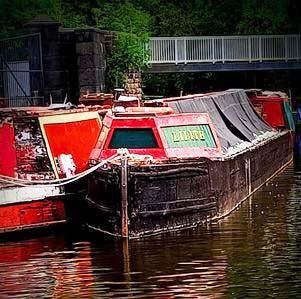
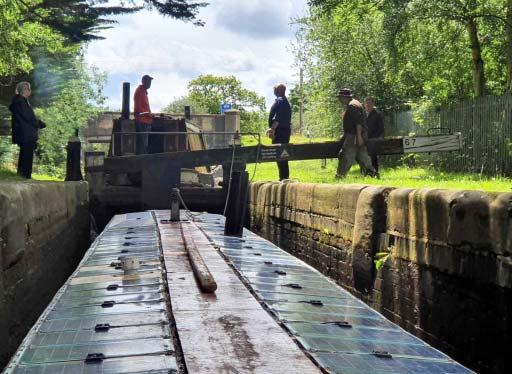
Celebrating the official opening of two liftbridges - including the one that we spent three weeks of summer camps working on in 2019...
A major restoration achievement was celebrated on Saturday 28th October when the Wey & Arun Canal Trust officially opened its first two lift bridges in Birtley, near Bramley in Surrey.
This completes the restoration of a 700 metre section of canal and construction of two lift bridges which means that the causeways that blocked the route of the canal have been removed.
At the southern of the two bridges (‘Bridge 1’), the fixed structure (abutments etc) was constructed with a great deal of support from visiting volunteers (WRG Canal Camps and the mobile groups NWPG, Kescrg and London WRG) including three weeks of consecutive camps in 2019. At the northern bridge (‘Bridge 2’) the work was largely done by WACT’s own volunteer teams. At both bridges the deck, lifting mechanism and associated steelwork were designed, built and erected by Beaver Bridges.
At the official opening by Mary Creswell, Deputy Lieutenant of Surrey attended by over 150 members and guests she paid tribute to the tremendous amount of work carried out by volunteers on the project and said “What a great achievement and an asset for Surrey”. At Bridge 1, whose restoration was sponsored by the Nicholson family (well known to WRG and particularly to NWPG) a plaque was unveiled in memory of Mary and Robin Nicholson “who loved and supported Britain’s canals”.
The two bridges are the biggest piece of the Canal Trust’s Birtley current restoration programme. In 2018 the canal was severely overgrown, inaccessible to the public and blocked by two causeways. The first task was to open a circular walk taking the path along the new section of canal, and back down the Downs Link path. This new walking route has been enormously appreciated by local residents and highlighted the benefit of a restored canal.
The distance between the two bridges is about 600m. The two bridges have the

same dimensions. They are 3.0m wide with a clear span of 4.5m. The steel decks weigh 3.5 tonnes with 1.5 tonnes of lifting frames and 4 tonnes of concrete counterweights. They are raised by hydraulic mechanisms, currently manually operated but with provision for solar electric power at such time as they begin to be regularly opened.
At the opening, WACT Chairman Sally Schupke commented that this project is big for the Canal Trust and big for Surrey and really demonstrates the achievements of our volunteers and what can be done and really benefits the community.
The Canal Trust is keen to improve the next section to the south (Fanesbridge/Rooks Hill). This will create more attractive canalside walks and recreation opportunities, as well as starting to close the gaps between the Birtley length and the restored Summit Level, Loxwood Link and other sections further south. An application for planning permission is currently with Waverley Borough Council.
For a longer report on the Wey & Arun restoration, particularly the projects involving volunteers, see Bill Nicholson’s piece in Navvies 321.
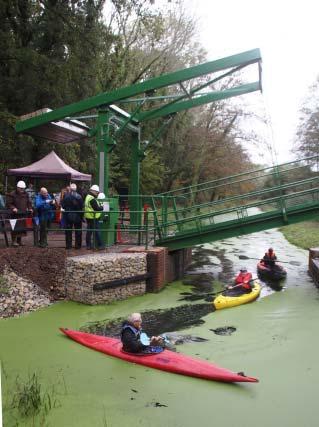
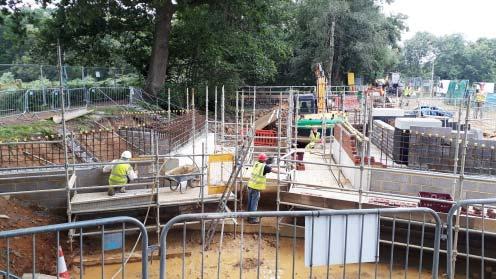
Chesterfield designs a new bridge to carry the Trans Pennine Trail over the canal, while Swansea looks forward to linking two watered lengths
The ‘Staveley Town Deal’ project, a scheme supported by a major grant from the Towns Fund to reinstate the next section of canal from the end of the isolated restored length at the new Staveley Town Lock eastwards to Doe Lee Puddlebank embankment, is approaching the construction phase.
This will involve a second new lock to return the canal to its original level (Staveley Town Lock lowered it to pass under a railway - one which, ironically, looks unlikely to see a train!), plus new bridges carrying footpaths, the Trans Pennine Trail (TPT), and local access across the new canal channel.
The first phase will involve building the TPT bridge, clearing the way for channel construction and the remaining work.
The basic design of the bridge is pictured below, detailed design is now under way.
Meanwhile with construction cost inflation eating into the resources of the project, Chesterfield Canal Trust has launched an appeal to raise funds for ‘nice to have’ but non-essential elements which might otherwise end up getting trimmed back. These include landscaping, planting, seating and interpretation. You may be just in time to support this via the Aviva Community Fund (with the Fund matching all contributions)see the Chesterfield Canal Trust website.
The TPT Bridge
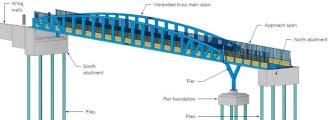
An event in October marked a significant step forward for the Swansea Canal restoration.
After several years’ work by the Swansea Canal Society volunteers and supporters, a previously infilled section in Clydach was officially opened as a mooring basin, which was watered for the first time, along with a launch ramp for canoeists, and a bywash channel. The project was supported by the Welsh Government’s ‘Brilliant Basics’ fund and other grants.
This is a precursor to restoring and reopening the adjacent lock, which has lain buried under a former council yard for decades. This will reconnect two lengths of canal together, potentially creating several miles of navigable waterway.

The newly rewatered Swansea Canal basin. See also back cover picture
The following appreciation was posted on the Shropshire Union Canal Society website. It is reproduced here at the suggestion of John Dodwell of the Montgomery Waterway Restoration Trust, who adds his own comments: “Rich was an invaluable volunteer in many ways in furthering the Montgomery Canal’s restoration. Not just in the physical work but also as Chair of the Society and in ensuring the new construction regulations were adhered to. I particularly have fond memories of the support he gave me within the Montgomery Canal Partnership where he represented SUCS.”
Rich Hamp, former Chair of the Shropshire Union Canal Society, sadly died on 30th August. He had been diagnosed with cancer a number of years ago and had endured this with his customary fortitude. I hope that these few words go some way toward summing up the man and his major contribution to the Society.
Rich joined the Society as a volunteer during the Newhouse Lock restoration in 2004. It quickly became apparent that he was most knowledgeable in all construction matters. Characteristically, he was always g enerous in sharing that knowledge. He soon showed a flair for organisation as well. He did an outstanding job in the organisation of the celebratory opening of Newhouse Lock 2006.
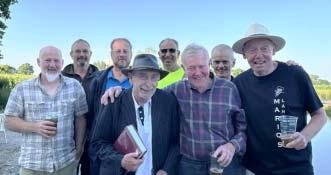
Rich came onto the Society Council shortly after Newhouse was finished whilst continuing his work as a volunteer. During the Redwith restoration project, he was largely responsible for the creation of the role of Welfare Officer as a part of the site management team. This meant that functions such as site welfare, accommodation and training were in his capable hands – thus relieving successive project managers of a considerable burden. Rich continued in the Welfare Officer role until his retirement in 2021 although, as always, he remained supportive of his successors in the various roles.
In 2015, he became acting Chair of Council and in 2017 became the permanent chair. He discharged this role with distinction until 2021 when he stood down due to ill health. Rich’s seven years in the hot seat saw the Society successfully overcome a number of major challenges. The first was to adapt the Society’s relationship with British Waterways to that with Canal & River Trust – as it turned out two very different org anisations. Although the Society has a long track record of successful restoration projects, he recognised that the main contractor role on the large scale works on the Pryces to Crickheath represented a big departure from what had gone before. He completely revised the Society’s health and safety systems and put them on a professional level. Rich has always been an advocate of forward planning and he initiated a succession plan for Council members and restoration volunteers which should ‘future proof ’ the Society.
Rich was still an attendee at work parties until the middle of this year. We are all beneficiaries of his company, technical help and sage advice. His last major contribution to the Society was the characteristically highly successful organisation of the June opening celebrations for the Pryces to Crickheath section of the Montgomery Canal. He can be seen at this event, as we want to remember him, in the centre of the picture.
Rich was a lovely man, unfailing civil and polite. He was entirely approachable by allcomers. His advice was always very perceptive and grounded, his outlook realistic, pra gmatic yet enthusiastic. Presented with a problem, he never sat back and did nothing, he just got stuck in and saw it through. He had a fine sense of humour and was a great bloke to have a pint with. He will be so very missed by all connected to the Society and the wider canal world.
David Carter, SUCS ChairWe don’t print Navvies ourselves these days (for various reasons including it getting too difficult to find anyone who could produce the right plates) but John Hawkins is still involved in its production, and has this message...
Many thanks to Martin Sach of the London Canal Museum for the continuing use of the facilities for our “stuffing” evenings; and also to those folks who turn up to spend the evening ‘labelling and stuffing’ Navvies and inserts into envelopes.
My apologies to all for some dates being cancelled and arrangements altered. One or two sessions have been completed during Camps or on the local groups’ weekend digs – either doing the complete task or just sticking labels on envelopes. This has mainly come about by delivery dates from the print company, that we generally use, or the availability of ‘suitable’ dates.
My intention is, where possible, to continue to use the facilities at the Museum. Thanks also to Martin L for all the work in producing such an interesting magazine on often a very short dead line, and to Chris Griffiths for his continuing help with printing. Once again thankyou to everybody for your help over the past year and looking on into 2024.
John Hawkins...also from the Navvies editor to everyone who has contributed words, pictures or anything else to the magazine’s content this year; also to Dave Wedd for getting the diary going again following the long gap during and after the pandemic when it was difficult to plan ahead; to Robert Goundry for rounding up, editing and supplying most of the progress reports; to John Hawkins and his team of volunteers at the London Canal Museum (or wherever) who stuff, stick and label the envelopes; to all at Head Office dealing with the subscriptions etc; to Lesley for proofreading; and to anyone else I’ve forgotten. All the best for Christmas and I’ll see some of you either on the New Year Camp or somewhere in 2024.
Martin LudgateI need help. Seriously, I need help. I need help to understand what else we can do to ensure that when a WRG van is damaged, someone tells us. Its not like we try and keep it a secret, we have a sticker on the windscreen, full details and flowcharts in the van folder and another flowchart on the bulkhead. All the information and processes are there for anyone (not just the driver) to see.
And yet, this year on two occasions there was damage to a van that was not reported. One was a dent in the back door, now this was blamed on an errant golf ball and not while being driven. Even if the van is parked up and gets damage, we still need to know about it (in this case if it had been reported at the time we could have made a claim for damage to the golf course).
The other incident was a damaged wing mirror, we keep some of the parts in stock for the mirror assemblies (mostly from hanging onto the good bits when one gets smashed) and if we had been told at the time of the incident we could have easily got the parts out to the van, instead it was just handed to the next camp to deal with and they reported it to us. I cannot comprehend how anyone sees that as acceptable.
To be clear, we absolutely understand that accidents will happen, I don’t think there is a member of the WRG board that hasn’t had an incident at some time or another. All we are asking is that you just bloody tell us about it when it happens!
So, as I said at the top, I need your help. All suggestions as to how to get people to actually tell us about the damage AT THE TIME rather than chasing around afterwards will be gratefully received.
George ‘Bungle’ EycottElections are due for the Canal & River Trust’s governing Council’s representatives for boating, angling, the ‘Friends of CRT’ group, employees, and (important for us!) volunteering. Anyone who is a CRT volunteer gets a vote. Without wanting to tell anyone who to vote for, one option is to re-elect Ian ‘Mac’ McCarthy, formerly of WRG NW and a good friend of WRG.
Dear Deirdre I’m desperate to bunk off from my dreadful relatives and join the Christmas Canal Camp. But I don’t want to burn any bridges with my family in case I need bone marrow from them in the future. What on earth can I tell them to escape on Boxing Day?
- Ciara, Forest of Dean
Deirdre writes A good way to avoid having to spend extended time with the family is to be as obnoxious as possible. Perhaps you could insist that they cater to your raw vegan gluten-free low-FODMAP diet, or you could tell them all about the exciting new religion you’ve just joined, or bring along an especially awful partner. They’ll be as keen to cut the visit short as you are.
Dear Deirdre Last year my nan gave me a hideous jumper for Christmas. It’s awful but it’s warm, so I decided to use it on site on a winter camp. Unfortunately my photo’s now all over Facebook tending bonfires while wearing the damn thing. My nan lives on Facebook and I know she’ll have seen the pics of me in the ruined jumper - how can I look her in the eye?
- Kevin from Solihull
Deirdre writes Kevin, I’m sure your nan will just be pleased you were nice and warm on site.
Do you have a question for Deirdre? Just email it to the editor martin.ludgate@wrg.org.uk
1: A partridge in a pear tree In which town would you find Woods and Partridges Lock?
2: Two turtle doves On which canal is the Dove Aqueduct?
3: Three French hens On which river is French Brothers’ boatyard?
4: Four calling birds Where would you find a trip-boat callled Birdswood?
5: Five gold rings Which new canal cruising ring has only been open since 2011?
6: Six geese a-laying On which canal is Fox and Goose Bridge?
7: Seven swans a-swimming Which canal junction is overlooked by the Swan pub?
8: Eight maids a-milking Who ran a 1960s boat hire company called Maid Line?
9: Nine ladies dancing On which canal is Lady’s Bridge?
10: Ten lords a-leaping Why is the boat horse leaping in Constable’s ‘The Leaping horse’?
11: Eleven pipers piping What type of canal boats do Piper Boats mainly build?
12: Twelve drummers drumming Which drummer lived by the Wey & Arun Canal until 2014?
Answers next time.
So what do you do when you’ve bought an enormous turkey to roast for the Saturday evening dinner on the KESCRG / London WRG / WRG Forestry Christmas dig, only for the village hall cooker to suffer an oven malfunction? Helpful suggestions included...
. Barbecue it on site on the bonfire
. Boil it in the spare Burco
. Fill the spare Burco with oil and deep-fry it
. Flatten it and fry it on the griddle
. Slice it up and grill it in the toaster, six slices at a time
Our thanks to Eli for saving the day with a delicious turkey stew. Happy Christmas everyone!
